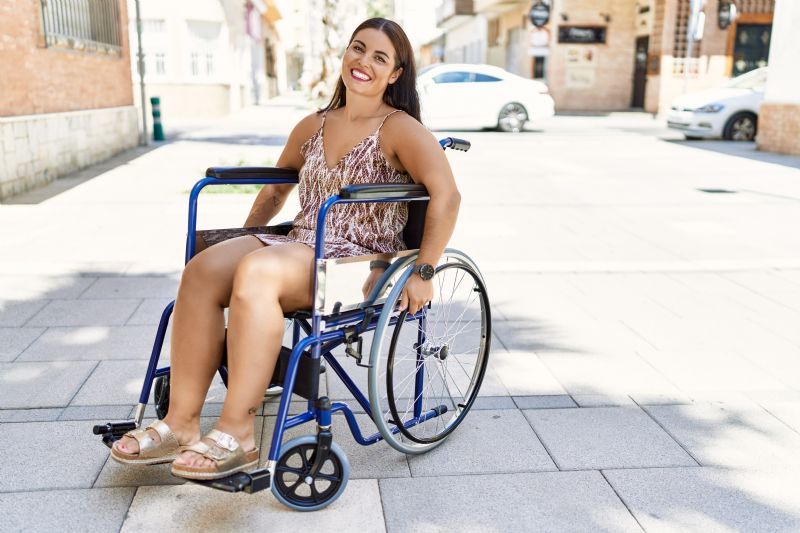We know people who need mobility assistance may look to wheelchairs or transport chairs to help them get around better. Research shows individuals with mobility concerns are less likely to engage in physical activity and interact with others. For this reason, someone with impaired mobility must use an appropriate mobility device. Some of the most common pieces of equipment for those with moderate to severe concerns are transport chairs and wheelchairs.
At RehabMart, we can tell you the difference between these chairs, from what features they include and the symptoms they are appropriate for. We can also show you a range of options and help you choose one that’s best for you.

Things to Consider:
Are transport wheelchairs easier to push?
Since transport chairs are lighter than standard wheelchairs, they may be easier to push. We also know, however, that transport chairs may be harder to turn when maneuvering tight spaces and corners.
What is the best wheelchair for home use?
There are many factors to consider, including ADA requirements, when choosing the best wheelchair for home use. Since wheelchairs and transport chairs have indoor and outdoor models, users might benefit from either depending on their needs. Visit Top Rated Manual Wheelchairs to read more about our favorite picks and features to consider.
What sizes do transport chairs come in?
In our experience, narrow transport chairs offer seats between 16 and 17 inches wide, medium transport chairs have seat widths of 18 to 20 inches, and wide transport chairs have seats 22 inches wide or more.
What is the best transport chair?
The best transport chair will allow you to sit comfortably for a short trip within the community or between rooms in your home. If you are looking for certain models that suit your needs, take a look at our Top Transport Wheelchairs.
Can a transport chair be used as a walker?
We know some transport chairs have a 2-in-1 design that allows them to serve as a walker and a transport chair without much effort. In particular, the Excel Translator Combo Transport Chair and Rollator by Medline enables users to walk behind the device and use hand brakes. Users can also benefit from ample storage and the option of using the device while seated if their energy levels warrant it.

When You Need a Transport Chair
- Your home, or the environment where you’ll primarily be using the chair, has narrow doors and halls
- You can’t propel a manual wheelchair on your own due to physical or cognitive limitations
- You need mobility assistance for brief periods, such as trips to the doctor or the store
- You do not need mobility assistance every day
When You Need a Standard Chair
- You will need mobility assistance for prolonged periods
- You will be using the wheelchair regularly or every day
- You need the chair only for home use
- Your home has halls, doors, and spaces that can accommodate the width of the chair
- You have medical concerns that require elevating leg rests
- You can manage a heavier chair on your own or with help
- You need a reclining seat

Differences Between a Wheelchair and Transport Chair
Wheel Sizes
- Standard Wheelchair: Standard wheelchairs have much larger rear wheels that range from 18 to 24 inches tall. Since standard wheelchairs are manual, they allow the user to reach and manipulate the handrail. As a result, users can propel themselves. Standard wheelchairs also have two large rear wheels and two small front wheels, which allows them more precise turning abilities. We love that there are indoor and outdoor models, so someone using a standard wheelchair can opt for tires that suit the environment of their choice.
- Transport Chair: Transport chairs have four small wheels ranging between 8 and 12 inches tall, so users cannot reach them. In our experience, this height means someone in a transport chair must rely on the assistance of a caregiver to push them where they need to go.
Self Propel vs. Caregiver Push
- Standard Wheelchair: Since the wheels are bigger on standard wheelchairs, they are positioned slightly below the chair’s armrest. The size allows users to grasp the handrail and push it to move their chair forward, which is called self-propulsion. The good news is that manual wheelchairs also come with handlebars at the back of the chair. These handlebars enable caregivers to push the wheelchair if the user cannot.
- Transport Chair: Due to the smaller wheel size, individuals using transport chairs cannot reach the wheels when seated. Therefore, transport chairs are only able to be pushed by a caregiver. As a result, we don’t recommend transport chairs to someone who has no assistance or to those who prefer to be more independent.
Wheelchair Weight
- Standard Wheelchair: Standard wheelchairs are for individuals who need full-time or part-time mobility assistance. For this reason, they are made of more durable steel and weigh more than transport chairs. Most standard wheelchairs weigh between 20 and 60 pounds.
- Transport Chair: Transport chairs are made of aluminum and weigh around 20 pounds. Part of their light weight is attributed to not having large rear wheels. Some individuals might opt for the ultra-lightweight model, which weighs even less at around 15 pounds.

Total Wheelchair Width
- Standard Wheelchair: We know the seat of a standard wheelchair is 18 to 22 inches wide. However, there are extra-large models with widths of 24 inches or more. When you add in the wheels and frame, the total width of a standard wheelchair is around 25 to 36 inches wide. The rule of thumb is: to estimate the width of the entire wheelchair you add 8 inches to the seat width.
- Transport Chair: Since transport chairs have much smaller wheels than standard wheelchairs, they are more narrow. Their seat width also equals their overall width. This sizing makes them a better choice for indoor navigation since they can move more smoothly through tight spaces. Some transport chairs are narrow with 16- to 17-inch seat widths. Medium transport chairs have 18- to 20-inch wide seats. There are also wider options, which offer seats 22 inches wide or greater.
Comfort
- Standard Wheelchair: Standard wheelchairs are typically the more comfortable option since they offer a variety of accessories and features. In our experience, we know many models that recline and have ergonomic backrests, cushions, padded handles, and more. These features help make users more comfortable since standard wheelchairs are for long-term use.
- Transport Chair: Over the years, we’ve learned that because they are designed for short trips, transport chairs are considered less comfortable than standard wheelchairs. Transport chairs most notably lack the padding that standard wheelchairs have.
Optional Accessories
- Standard Wheelchair: Standard wheelchairs have many options for accessories, such as tray tables, cup holders, storage pouches, cushions, attachments for oxygen tanks and other medical devices, mirrors, phone holders, weatherproof covers, gloves for self-propelling, and more.
- Transport Chair: These chairs are better for short-term use, so users don’t often get accessories. One of the only main features is swing-away footrests that allow the user to choose between some leg support or none.
Brakes
- Standard Wheelchair: Brakes are at the top of each rear wheel so users can control them by pushing to lock. Caregivers can also access the brakes in this position.
- Transport Chair: Transport chairs have rear-locking brakes that caregivers can engage with their hands by squeezing the handlebars. Some models also offer foot-controlled brakes that caregivers step down on.

Final Thoughts
When choosing a transport chair or standard wheelchair, users must consider the device’s features. For those interested in shorter trips periodically, a transport chair might be best. However, a standard wheelchair offers greater comfort and more features for individuals who need more regular mobility assistance. Regardless of what device you settle on, it's crucial to contact your insurance company to determine how much coverage they will offer. If you need further help searching for a new mobility device, visit Caregiver University to read similar articles.
Author:
Brittany Ferri, OTR/L
Brittany is an occupational therapist who has worked in a variety of rehab facilities. She has always expressed an interest in patients’ internal motivation for therapy and the use of assistive devices, which led her to pursue a PhD in Integrative Mental Health. This research-based training has also led her to develop her writing career to educate patients of all ages on how to improve their health. Brittany has published four books, written over 300 articles, and has been quoted in media outlets such as WebMD, Healthline, and NBC News.
Meet all of our experts here!
 Written by Brittany Ferri, OTR/L
Written by Brittany Ferri, OTR/L





